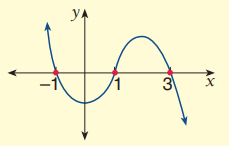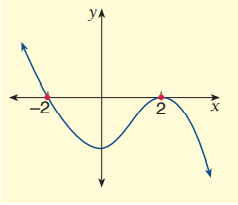FROM THE GIVEN INFORMATION WRITE THE CUBIC FUNCTION
Subscribe to our ▶️ YouTube channel 🔴 for the latest videos, updates, and tips.
To find cubic equation from the given zeroes, x-intercepts, solutions or values of x, we use the formula given below.
y = k(x - a) (x - b) (x - c)
Here a, b and c are x-intercepts.
Difference between touches and crosses :

Here the curve crosses the x-axis at three different points.

The curve crosses x-axis at -2 and touches the x-axis at 2. So, we have to take the factor (x - 2) twice. So, the equation would be y = (x + 2)(x - 2)2
Find the equation of the cubic whose graph :
Problem 1 :
Cuts the x - axis at 3, 1, -2 and passes through (2, -4)
Solution :
x = 3, x = 1, x = -2
Factors are :
(x - 3) (x - 1) (x + 2)
P(x) = a (x - 3) (x - 1) (x + 2) --- (1)
Then solve for a. substitute passes through the points (2, -4).
-4 = a (2 - 3) (2 - 1) (2 + 2)
-4 = a (-1) (1) (4)
-4 = -4a
1 = a
a = 1 substitute the equation (1).
P(x) = (x - 3) (x - 1) (x + 2)
Problem 2 :
Cuts the x - axis at -2, 0 and 1/2 and passes through (-3, -21)
Solution :
x = -2, x = 0, x = 1/2
Factors are :
(x + 2) (x - 0) (x - 1/2)
P(x) = a (x + 2) (x - 0) (x - 1/2) --- (1)
Then solve for a. substitute passes through the points (-3, -21).
-21 = a (-3 + 2) (-3 - 0) (-3-(1/2))
-21 = a (-1) (-3) (-7/2)
-21 = -21a/2
(-21) (-2/21) = a
2 = a
a = 2 substitute the equation (1).
P(x) = 2(x + 2) (x) (x - 1/2)
Problem 3 :
Touches the x - axis at 1, cuts the x- axis at -2 and passes through (4, 54)
Solution :
x = 1 and x = -2
(x - 1) and (x + 2)
The factor (x - 1) should be repeated twice.
P(x) = a(x - 1)2 (x + 2) --- (1)
Then solve for a. substitute passes through the points (4, 54).
54 = a(4 - 1)2 (4 + 2)
54 = a(3)2 (6)
54 = 54a
1 = a
a = 1 substitute the equation (1).
P(x) = (x - 1)2 (x + 2)
Problem 4 :
Touches the x - axis at -2/3, cuts the x- axis at 4 and passes through (-1, -5)
Solution :
x = -2/3 and x = 4
(x + 2/3) and (x - 4)
P(x) = a(x + 2/3)2 (x - 4) --- (1)
Then solve for a. substitute passes through the points (-1, -5).
-5 = a(-1/3)2 (-5)
-5 = (a/9) (-5)
-5 = -5a/9
(-5) (-9/5) = a
9 = a
a = 9 substitute the equation (1).
P(x) = 9[(3x + 2)/3]2 (x - 4)
= (9) (1/9) [3x + 2]2 (x - 4)
= (3x + 2)2 (x - 4)
Find the equation of a real cubic polynomial which cuts :
Problem 5 :
The x - axis at 1/2 and -3, cuts the y - axis at 30 and passes through (1, -20)
Solution :
From the given x-intercepts, we get (x - 1/2) (x + 3). Let another zero of the cubic polynomial be c.
(x - 1/2) (x + 3) and (x - c)
P(x) = k(x - 1/2) (x + 3) (x - c) -----(1)
y-intercept, when x = 0
P(0) = k(0 - 1/2) (0 + 3) (0 - c)
30 = k(-1/2) (-3c)
20 = ck -------(1)
The curve passes through the point (1, -20)
-20 = k(1 - 1/2) (1 + 3) (1 - c)
-20 = k(1/2) (4) (1 - c)
-10 = k(1 - c)
From (1), k = 20/c
-10 = (20/c)(1-c)
-10c = 20(1 - c)
-c = 2(1 - c)
c = 2, k = 10
= 10 (1/2) (2x - 1) (x + 3) (x - 2)
P (x) = 5(2x - 1) (x + 3) (x - 2)
Problem 6 :
The x - axis at 1, touches the x - axis at -2 and cuts the y - axis at (0, 8)
Solution :
x = 1 and x = -2
(x - 1) (x + 2)
P(x) = k (x - 1) (x + 2)2
Then solve for a. substitute passes through the points (0, 8).
8 = k (0 - 1) (0 + 2)2
8 = k(-1) (2)2
-8/4 = k
a = -2
P(x) = -2 (x - 1) (x + 2)2
Problem 7 :
The x - axis at 2, the y- axis at -4 and passes through (1, -1) and (-1, -21)
Solution :
Cubic equation will be the form k(x - a) (x - b) (x - c). Here a, b and c are x-intercepts.
With the given x-intercept, we create a linear factor (x - 2)
y axis = (0, -4)
Since the graph passes through the points (1, -1) and (-1, -21).
P(x) = (x - 2) (ax2 + bx + c) --- (1)
(0, -4) substitute the equation (1).
-4 = (0 - 2) (a(0)2 + b(0) + c)
-4 = -2c
2 = c
c = 2 and (1, -1) substitute the equation (1).
-1 = (1 - 2) (a(1)2 + b(1) + 2)
-1 = (-1) (a + b + 2)
a + b = 1 - 2
a + b = -1
The curve passes through the point (-1, -21).
-21 = (-1 - 2) (a(-1)2 + b(-1) + 2)
7 = a - b + 2
a - b = 5 ---(2)
(1) + (2)
2a = 4, then a = 2
By applying the value of a in (1), we get
2 + b = -1
b = -3
Applying the values, we get
P(x) = (x - 2) (2x2 - 3x + 2)
Subscribe to our ▶️ YouTube channel 🔴 for the latest videos, updates, and tips.
Recent Articles
-
Finding Range of Values Inequality Problems
May 21, 24 08:51 PM
Finding Range of Values Inequality Problems -
Solving Two Step Inequality Word Problems
May 21, 24 08:51 AM
Solving Two Step Inequality Word Problems -
Exponential Function Context and Data Modeling
May 20, 24 10:45 PM
Exponential Function Context and Data Modeling